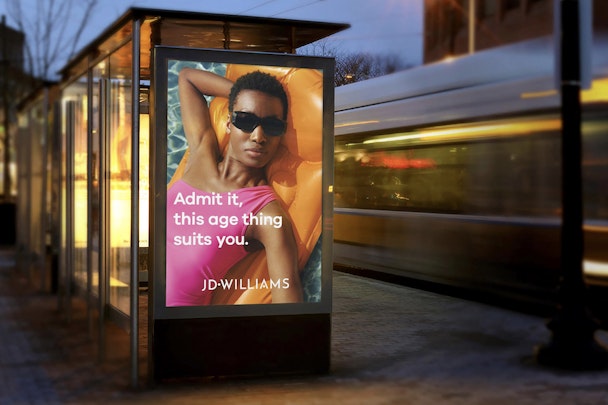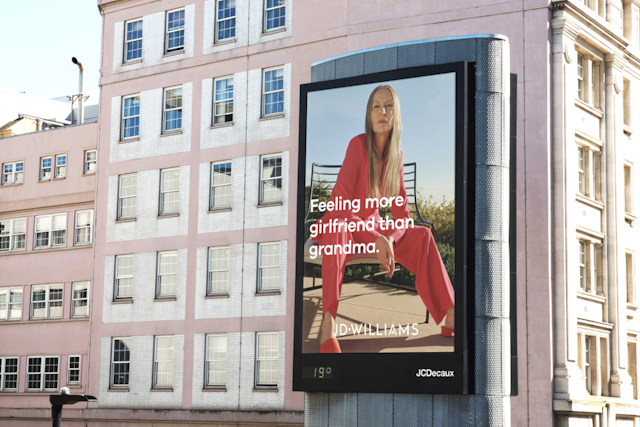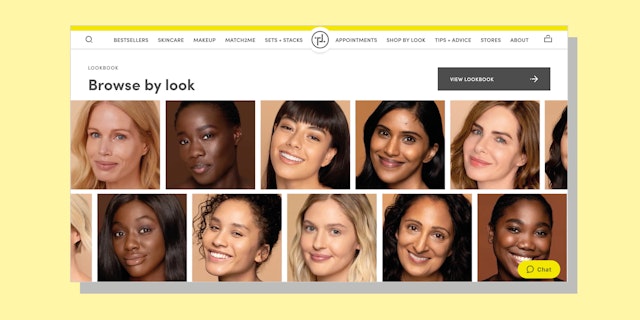Calling ‘bullshit’ on ageism in advertising: lessons from JD Williams & Trinny London
Only 4% of people in ads are over the age of 60, despite that demographic controlling 25% of consumer spending. We look at how to plan and execute age-inclusive marketing campaigns.

JD Williams Spring/Summer 2023 campaign / JD Williams
CreativeX recently assessed over 126,000 ads from around the world and found that just 4% of the people cast in them were over the age of 60. Not only that, but almost two-thirds of that 4% were featured in family and domestic settings and less than 1% were cast in ads that put them in professional or leadership environments.
The over-60s demographic accounts for 25% of global spending power, yet CreativeX found that just 3% of digital media budgets are allocated to ads featuring that audience.
In 2019 The Drum published results from a similar study, along with adland insight on the reasons why advertising was still having a problem with agism. Fast forward four years and the data remain the same. We could write another story analyzing the reasons why ageism is still so bad in advertising, but instead, we wanted to ask brands and agencies what is needed to create age-inclusive brands and marketing.
Advertisement
Centre for Ageing Better is an organization campaigning for better representation in advertising. Its director of communications and policy, Emma Twyning, says some brands, such as Marks & Spencer, are getting age inclusivity right. “It is a good example of a brand using an increasingly diverse range of models in its advertising, covering different ages, ethnicities and body shapes. Its adverts show strong intergenerational engagement and avoid the stereotypes of older models looking or behaving differently to younger counterparts.”
This is in stark contrast, she says, to most adverts that portray older demographics as “passive and disempowered” while showing younger people with more “vibrant and active lives.”
Twyning also applauds Dove, for its “long-term commitment to targeting and talking to older consumers about aging in a positive tone“ and its commitment to “not ignore or airbrush out the realities of aging, such as age spots, curves and grey hair, but to celebrate them instead.”
And then there is JD Williams, the online fashion retailer whose spring/summer campaign by House 337 challenged harmful stereotypes. “The advertising really exudes confidence, self-assuredness and zest for life of older women – and with a sense of humor and a sexuality that is often absent in marketing to older age groups.”
The campaign featured a cast of older models accompanied by copy such as ‘No it’s not my daughter’s, and yes I still look hot,’ ‘Feeling more girlfriend than grandma’ and ’Admit it, this age thing suits you.’

House 337’s executive creative director, Zara Ineson, was behind the campaign and tells us that while JD Williams has always been aware of its over-50s demographic, “creatively, I didn’t believe we were talking to her in the right way.” The campaign came from a long piece of work that the agency took proactively to JD Williams.
“The brand already knew who it wanted to speak to and the agency kind of called bullshit on how it wasn't speaking to them, then together we got the stories straight.”
She recalls that it took almost a year to get a new strategy in place and to get everyone to sign up for the new direction. “Without that foundational work, we wouldn’t have got there.”
Advertisement
To ensure JD Williams accurately represents its older audiences, House 337 uses social listening and helps the brand set a year-round test group of women from all demographics and parts of the UK that it runs creative executions through.
Another element (which Ineson believes is the most crucial part) is that either the people writing the work or signing off the work should have lived experience. “It’s very easy to pop a really amazing Cannes-winning young creative team on a piece of work, but then they aren’t writing from a place of truth you miss out on the nuances of telling the right story and fall into cliches.”
On House 337’s JD Williams work, 99% of the production team are women and over 85% were over the age of 35. “We are being very conscious when we put together teams, sign off work or are working with the client that decisions are made from a place of experience rather than just research alone. Putting people around the world has been really important to the success of the work.”
Suggested newsletters for you
Celebrating growing older
The makeup company Trinny London has made a name for itself for being age-positive. Founded by TV personality Trinny Woodall when she was in her mid-50s, Trinny London aims to celebrate growing older instead of making women feel ashamed of wrinkles and age spots.
Its chief marketing officer, Shira Feuer, tells The Drum that to ensure this ethos is reflected on its website and in its marketing activity, Trinny London uses models aged 18 to 83 with varying skin types, hair colors and skin tones. “This way, we know that when customers head to our website or Instagram they can see what our products look like on people who look like them, women they can identify with so they feel confident in what they are purchasing knowing how it will look and feel for them.”

Because Trinny London has positive age representation baked into it, Feuer says: “Partner agencies know what we stand for as our values run through everything we put out. This is clear in all the assets we produce, so it’s never a surprise.”
She adds that since age inclusion gives the brand a point of difference, agencies “see this as a benefit to help them achieve the objectives” they set together.
For Feuer, transparency is crucial to marketing inclusion. “We’re honest about the fact that, no matter how great a product might be, it can never make you look 21 again – and that’s OK.”
While brands like JD Williams, M&S, Trinny London and Dove have all made great strides in age-inclusivity, they do remain outliers in the industry. There is still a lot of progress to be made to avoid the same statistics being published another four years down the line.

